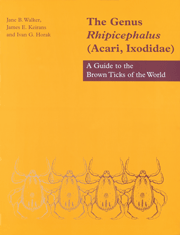Book contents
- Frontmatter
- Contents
- Acknowledgements
- 1 Introduction
- 2 Relationships of the ticks (Ixodida) and definition of the genus Rhipicephalus
- 3 Format for the accounts of individual species
- 4 Glossary
- 5 Rhipicephalus species names of the world
- 6 Rhipicephalus species occurring in the Afrotropical region
- 7 Accounts of individual species occurring in the Afrotropical region. pages 59 to 277
- Accounts of individual species occurring in the Afrotropical region. pages 278 to 490
- 8 Host/parasite list for the Afrotropical Rhipicephalus species
- 9 Rhipicephalus species occurring outside the Afrotropical region
- 10 Accounts of individual species occurring outside the Afrotropical region
- 11 Host/parasite list for the non-Afrotropical Rhipicephalus species
- 12 Species groups based on the immature stages
- 13 The transmission of tick-borne diseases of animals and humans by Rhipicephalus species
- Index
7 - Accounts of individual species occurring in the Afrotropical region. pages 59 to 277
Published online by Cambridge University Press: 05 November 2011
- Frontmatter
- Contents
- Acknowledgements
- 1 Introduction
- 2 Relationships of the ticks (Ixodida) and definition of the genus Rhipicephalus
- 3 Format for the accounts of individual species
- 4 Glossary
- 5 Rhipicephalus species names of the world
- 6 Rhipicephalus species occurring in the Afrotropical region
- 7 Accounts of individual species occurring in the Afrotropical region. pages 59 to 277
- Accounts of individual species occurring in the Afrotropical region. pages 278 to 490
- 8 Host/parasite list for the Afrotropical Rhipicephalus species
- 9 Rhipicephalus species occurring outside the Afrotropical region
- 10 Accounts of individual species occurring outside the Afrotropical region
- 11 Host/parasite list for the non-Afrotropical Rhipicephalus species
- 12 Species groups based on the immature stages
- 13 The transmission of tick-borne diseases of animals and humans by Rhipicephalus species
- Index
Summary
RHIPICEPHALUSAPPENDICULA TUS NEUMANN, 1901
This specific name appendiculatus, from the Latin appendo meaning ‘to hang’, doubtless refers to the appearance of the engorging adults.
Diagnosis
A moderate-sized reddish-brown tick.
Male (Figs 3(a), 4(a) to (c))
Capitulum much longer than broad, length × breadth ranging from 0.69 mm × 0.56 mm to 0.86 mm × 0.71 mm. Basis capituli of smaller males much broader than long but that of larger males only slightly broader than long, with very short obtuse lateral angles at about anterior quarter of its length. Palps short, broad. Conscutum length × breadth ranging from 2.85 mm × 1.85 mm to 3.67 mm × 2.43 mm; large sharp strongly-sclerotized anterior process present on coxae I. In engorged specimens body wall expanded slightly posterolaterally and forming a long slender caudal process posteromedially. Eyes marginal, almost flat, delimited dorsally by a very shallow groove and sometimes one or two large punctations. Cervical fields broad, depressed, with finely-reticulate surfaces. Marginal lines well developed, extending anteriorly nearly to eye level, delimiting one festoon posteriorly. Posteromedian groove long and narrow, posterolateral grooves short and broad, all with finely-reticulate surfaces. Large setiferous punctations present on the scapulae, along the outer margins of the cervical fields and scattered amongst numerous medium-sized punctations medially on the conscutum. Areas surrounding the eyes, adjacent to the marginal lines and anterior to the festoons with fine pinpoint punctations only. In small specimens the pattern of grooves and punctations may be much reduced. Legs increase markedly in size from I to IV. Ventrally spiracles broadly comma shaped, curving gently towards the dorsal surface.
- Type
- Chapter
- Information
- The Genus Rhipicephalus (Acari, Ixodidae)A Guide to the Brown Ticks of the World, pp. 59 - 277Publisher: Cambridge University PressPrint publication year: 2000

